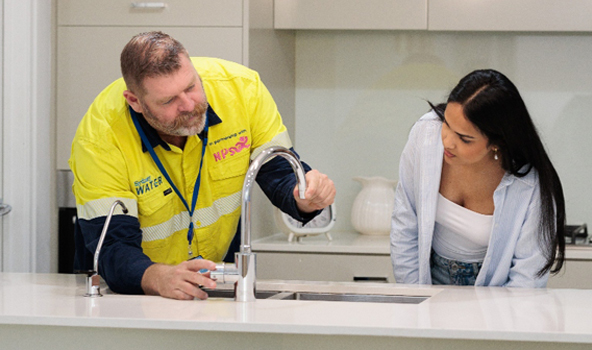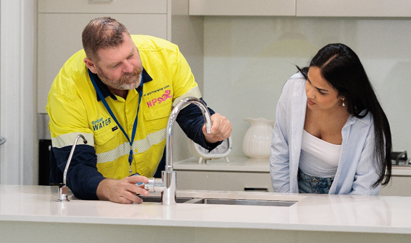Try to work out which tank size will deliver the greatest savings for your home. Some websites and apps can help you find the right tank size. You’ll also need to consider your budget and how much space you have. Don't forget to pour a concrete foundation.
Log in
Make the most of a precious free resource
Install a rainwater tank to save water and stay environmentally friendly. Find out how to pick the right tank, get expert support and meet all the requirements.
1. Check the regulations
Tanks that can store a maximum of 10,000 litres of water don't normally need council approval. However, you must comply with a number of conditions. For the latest information about exempt and complying development, visit NSW Planning & Infrastructure for the latest copy of the NSW Housing Code.
If you want to use the water from your rainwater tank in your toilet or washing machine, you must:
- assess the site
- check your backflow prevention requirements, as you may need to install a property-specific backflow device.
2. Check the location
You need to check the suitability of the proposed location well before the tank arrives so you can:
- maximise the tank's catchment area
- minimise the plumbing and connection costs
- provide a safe and stable foundation, as the tank will be heavy once it's full of water – 1,000 litres weighs 1 tonne.
Read Subdivisions 32 and 33 of the State Environmental Planning Policy (Exempt and Complying Development Codes) 2008 and ask a good tank supplier for site-specific considerations.
3. Find the right tank
Research rainwater tanks before you make a decision and get quotes from at least 3 suppliers. We've outlined some of the key considerations.
Tanks come in a wide variety of sizes, shapes and colours. You can also choose a below-ground tank. These are much more expensive to buy and install, and need extra backflow-prevention measures. Where you can position your tank will influence the type of tank you can use.
Most tanks need a pump to supply water at the same pressure as your drinking water supply. These may be external pumps that sit on the ground or submersible pumps that sit inside the tank.
- External pumps tend to be more durable and last longer.
- Submersible pumps are considered to be quieter. As a submersible pump is inside the tank, it doesn't take up extra space. Ideally, submersible pumps should have their intake raised from the bottom. This stops the pump from taking in any dirt that settles at the bottom of the tank.
There can be a variety of problems that affect your pump and stop it from working, including water leaking into the pump and shorting the circuit, or parts deteriorating due to wear and tear. If you have a problem with your submersible pump, we recommend that you contact a pump repair specialist to assess and quote to fix it. If you need a new pump, buy an external pump if possible and ensure it's fit for purpose.
We recommend a small external pump for simple residential use. This will depend on your property size, irrigation needs and how you use rainwater in your home. Smaller pumps tend to be more energy efficient. You can buy a pump cover to minimise noise and protect the pump from the elements.
Consider how the tank connects to your home's downpipes and then to the stormwater pipes. Maximising the roof area flowing to your tank is the best way to maximise your water savings, regardless of tank size.
If price is a factor, consider a minimum tank size of 2,000 litres connected to 75% or more of your roof area. Make sure you can afford to have it connected to at least one regularly used internal plumbing fixture like a toilet or washing machine and to as much of your roof as possible. This will help ensure you receive maximum value from your purchase.
4. Install your tank
Remember that your tank's job is to deliver clean, clear water, so use the installation checklist below when you're installing it.
Installation checklist
- Check that your roof and guttering are suitable to collect rainwater. Don't collect rainwater from roofs with lead-based paint or flashing, bitumen-based products, or exposed treated wood.
- Prevent blockages from overhead trees by installing gutter guards or downpipe screens.
- Prevent insects and any other animals from entering your tank. Your rainwater tank inlet and overflow must be mosquito proof and you must ensure there's no other point of entry.
- Use a first-flush device. This is a simple and effective way of only letting the cleanest water into your tank.
- Install a fail-safe, top-up water connection or an auto-switching device to supply drinking water when the tank is empty.
- Add energy-efficient accessories like a pressure tank to your pump. These reduce the number of times your pump runs, saving energy and maximising the pump's life.
- Consider how you'll use your rainwater before you buy a water filter. Many aren't suited for rainwater as they clog quickly. This can increase your pump's energy use.
Once installed, find out about maintaining your rainwater tank.
5. Connect your tank
We recommend that you hire a licensed plumber who's experienced with rainwater tank installations. You may also need an electrician to provide a safe power supply for your pump and auto-switching device.
Your tank will need plumbing connections to deliver water from your:
- downpipes to your tank
- tank (when it's overflowing) to the stormwater system
- tank to your pump
- pump to your garden taps, toilets, washing machine, hot water system or household plumbing.
6. Have your plumbing inspected
Visit NSW Fair Trading to see if the plumbing work needs to be inspected or call them for more information. Don't forget to ask your plumber for your Certificate of Compliance when the work is done. This certifies that the plumbing work meets the current Plumbing Code of Australia.


